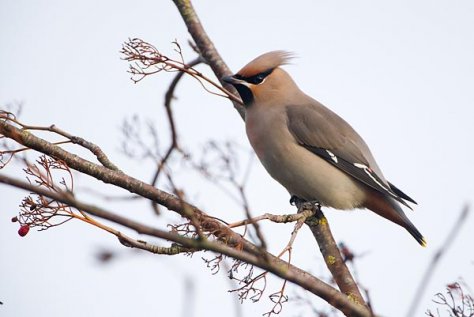Waxwings migrating
Photo: Arne Ader
Translation: Liis
Waxwing
Waxwing Siidisaba or viristaja Bombycilla garrulus
Waxwings have nested in Estonia in only very rare cases. Passing migrants from Finland, Sweden and Karelia have already been seen for some weeks. A larger migration is coming in November-December. Some twenty thousand birds may remain here for the winter.
The birds with the beautiful plumage live in flocks, without being shy of humans – when they are disturbed the company often only flies to a neighbouring tree. They don’t meet many people in the tundra and forest zones, hence the lack of a sense of fear.
The difference between juveniles and adults is small but noticeable: the young lack the characteristic black patch on the throat and the silky sheen is duller. Here is a description of the exterior of adults: the basic colours of the silkily gleaming plumage are reddish-brown and grey. The eyes have a black stripe, a patch of the same colour on the throat, and a strong beak with a slightly hooked tip. All have a splendid crest. Wing feathers are black, with yellow and white flecks (if red colour is noticeable at the tips of the wing primaries we probably have to do with an older male bird) as well as the tip of the tail. In flight the characteristic incessant twittering sound is heard.
They are very greedy at feeding. A bird flock can clear out a rowan, juniper, wild rose, aronia or hawthorn of berries in short time, and a thick berry mush remains under the trees and shrubs.
After repeated night frosts when the berries have frozen on the trees and thawed again a fermenting process starts and the behaviour of the greedy little birds can appear a little drunk.
A description of this incident was sent to LK today from the centre of Tallinn:
Before lunch on Friday some twenty waxwings in a flock were feasting on the berries in a rowan. There was a lot of bickering in the flock. Suddenly one bird, excited by the quarrelling, flew into the second-floor window of a house beside the tree, was badly injured, fell down ... the collision was fatal for the bird.









